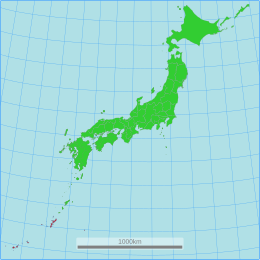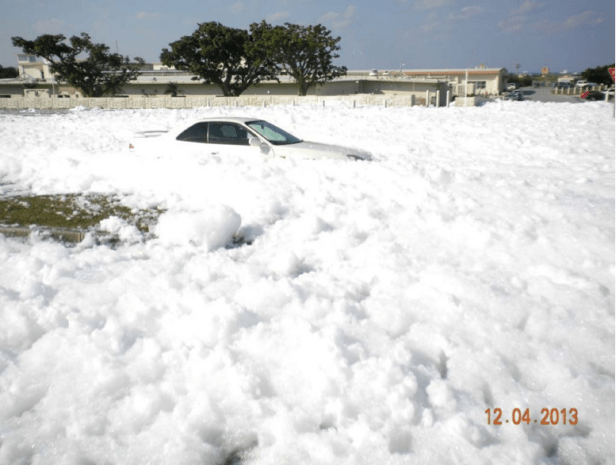More languages
More actions
(Created) Tag: Visual edit |
(US military pollution) Tag: Visual edit |
||
| Line 1: | Line 1: | ||
{{Infobox settlement|conventional_long_name=Okinawa Prefecture|native_name=沖縄県|area_km2=2,281|population_census=1,466,870|population_census_year=2020|capital=Naha|largest_city=Naha}} | {{Infobox settlement|conventional_long_name=Okinawa Prefecture|native_name=沖縄県|area_km2=2,281|population_census=1,466,870|population_census_year=2020|capital=Naha|largest_city=Naha|image_map=Okinawa map.svg|map_width=260|image_flag=Flag of Okinawa.svg}} | ||
'''Okinawa Prefecture''' is the southernmost prefecture of [[Japan]]. Although it makes up less than 1% of Japan's land area, it contains three-quarters of the [[United States of America|U.S.]] military bases in Japan and 30,000 U.S. soldiers.<ref name=":0">{{Web citation|author=Moé Yonamine|newspaper=Zinn Education Project|title=Fighting for Okinawa — My Home, Not a Military Base|date=2017-07-27|url=https://www.zinnedproject.org/if-we-knew-our-history/fighting-for-okinawa/|archive-url=https://web.archive.org/web/20210516012227/https://www.zinnedproject.org/if-we-knew-our-history/fighting-for-okinawa/|archive-date=2021-05-16|retrieved=2022-09-13}}</ref> | '''Okinawa Prefecture''' is the southernmost prefecture of [[Japan]]. Although it makes up less than 1% of Japan's land area, it contains three-quarters of the [[United States of America|U.S.]] military bases in Japan and 30,000 U.S. soldiers.<ref name=":0">{{Web citation|author=Moé Yonamine|newspaper=Zinn Education Project|title=Fighting for Okinawa — My Home, Not a Military Base|date=2017-07-27|url=https://www.zinnedproject.org/if-we-knew-our-history/fighting-for-okinawa/|archive-url=https://web.archive.org/web/20210516012227/https://www.zinnedproject.org/if-we-knew-our-history/fighting-for-okinawa/|archive-date=2021-05-16|retrieved=2022-09-13}}</ref> | ||
| Line 9: | Line 9: | ||
=== Second World War === | === Second World War === | ||
The United States invaded Okinawa in April 1945. A third of the Okinawan population was killed and over 90% of the survivors became homeless.<ref name=":0" /> The United States | The United States invaded Okinawa in April 1945. A third of the Okinawan population was killed and over 90% of the survivors became homeless.<ref name=":0" /> | ||
=== U.S. occupation === | |||
The United States directly controlled Okinawa until 1972, when it became a prefecture of Japan.<ref>{{Web citation|author=Lacei Amodei|newspaper=[[Liberation News]]|title=Okinawan women fight against GI abuses|date=2008-03-04|url=https://www.liberationnews.org/08-03-04-okinawan-women-fight-against-gi-html/|archive-url=https://web.archive.org/web/20190714121710/https://www.liberationnews.org/08-03-04-okinawan-women-fight-against-gi-html/|archive-date=2019-07-14|retrieved=2022-09-13}}</ref> In 2016, 65,000 people protested against the U.S. military presence in Okinawa.<ref>{{Web citation|author=Andrea Germanos|newspaper=[[MintPress News]]|title=‘Our Anger Is Past Its Limit’: Tens Of Thousands Rally Against US Bases In Okinawa|date=2016-06-20|url=https://www.mintpressnews.com/anger-past-limit-tens-thousands-rally-us-bases-okinawa/217349/|archive-url=https://web.archive.org/web/20210126213048/https://www.mintpressnews.com/anger-past-limit-tens-thousands-rally-us-bases-okinawa/217349/|archive-date=2021-01-26|retrieved=2022-09-13}}</ref> | |||
== Pollution == | |||
[[File:Okinawa pollution.png|thumb|Toxic foam at Kadena Air Base in Okinawa]] | |||
U.S. military bases are polluting the Okinawan environment with carcinogens including per- and polyfluoroalkyl substances (PFAS). The concentration of PFAS in the blood of Okinawans is more than 10 ng/mL in six towns and cities and above 20 in three.<ref>{{Web citation|author=Pat Elder|newspaper=[[CovertAction Magazine]]|title=The U.S. Military is Poisoning Okinawa|date=2022-12-28|url=https://covertactionmagazine.com/2022/12/28/the-u-s-military-is-poisoning-okinawa/|archive-url=https://web.archive.org/web/20221230011158/https://covertactionmagazine.com/2022/12/28/the-u-s-military-is-poisoning-okinawa/|archive-date=2022-12-30|retrieved=2022-12-30}}</ref> | |||
== References == | == References == | ||
<references /> | |||
[[Category:Prefectures of Japan]] | |||
Revision as of 14:12, 30 December 2022
Okinawa Prefecture 沖縄県 | |
|---|---|
|
Flag | |
 | |
| Capital and largest city | Naha |
| Area | |
• Total | 2,281 km² |
| Population | |
• 2020 census | 1,466,870 |
Okinawa Prefecture is the southernmost prefecture of Japan. Although it makes up less than 1% of Japan's land area, it contains three-quarters of the U.S. military bases in Japan and 30,000 U.S. soldiers.[1]
History
Japanese colonization
Okinawa was an independent kingdom until being colonized by Japan in 1879. The Empire of Japan suppressed Okinawan language and culture.[2]
Second World War
The United States invaded Okinawa in April 1945. A third of the Okinawan population was killed and over 90% of the survivors became homeless.[1]
U.S. occupation
The United States directly controlled Okinawa until 1972, when it became a prefecture of Japan.[3] In 2016, 65,000 people protested against the U.S. military presence in Okinawa.[4]
Pollution

U.S. military bases are polluting the Okinawan environment with carcinogens including per- and polyfluoroalkyl substances (PFAS). The concentration of PFAS in the blood of Okinawans is more than 10 ng/mL in six towns and cities and above 20 in three.[5]
References
- ↑ 1.0 1.1 Moé Yonamine (2017-07-27). "Fighting for Okinawa — My Home, Not a Military Base" Zinn Education Project. Archived from the original on 2021-05-16. Retrieved 2022-09-13.
- ↑ Elliott Gabriel (2018-03-01). "Amid Marine Base Hazards, Okinawa Struggles With New Wave of US & Japanese Militarization" MintPress News. Archived from the original on 2021-05-12. Retrieved 2022-09-13.
- ↑ Lacei Amodei (2008-03-04). "Okinawan women fight against GI abuses" Liberation News. Archived from the original on 2019-07-14. Retrieved 2022-09-13.
- ↑ Andrea Germanos (2016-06-20). "‘Our Anger Is Past Its Limit’: Tens Of Thousands Rally Against US Bases In Okinawa" MintPress News. Archived from the original on 2021-01-26. Retrieved 2022-09-13.
- ↑ Pat Elder (2022-12-28). "The U.S. Military is Poisoning Okinawa" CovertAction Magazine. Archived from the original on 2022-12-30. Retrieved 2022-12-30.

